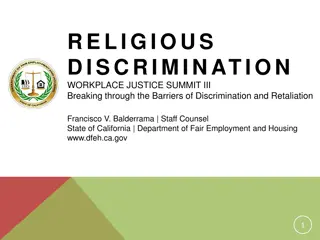Evolution of Akbar's Religious Policy: A Historical Overview
In the 16th century, Akbar the Great implemented a revolutionary religious policy in the Mughal Empire. Initially a devout Sunni Muslim, Akbar evolved his stance to promote harmony and equality among all religions, fostering tolerance and understanding. This shift marked a significant departure from the religious conflicts prevalent in Europe and West Asia during that era. Akbar's approach to religious pluralism facilitated unity and peace within the diverse cultural landscape of India.
Download Presentation

Please find below an Image/Link to download the presentation.
The content on the website is provided AS IS for your information and personal use only. It may not be sold, licensed, or shared on other websites without obtaining consent from the author. Download presentation by click this link. If you encounter any issues during the download, it is possible that the publisher has removed the file from their server.
E N D
Presentation Transcript
EVOLUTION OF AKBARS RELIGIOUS POLICY Presented by Dr. Sankar Kumar Biswas
Religious condition of the World in the 16thCentury In the 1500s and 1600s AD, many Europeans and West Asians tried to force other people to believe in their religion and their God. European wars erupted between Catholics and Protestants. In America, the Spanish forced millions of Aztec, Maya, and Quechua people to become Christians. In West Asia, the Shiite Safavids fought the Sunni Ottomans. But in China, Buddhists, Confucianists, and Taoists mixed their beliefs and got along. India was on the middle path: There were Muslims, Hindus, Buddhists, Sikhs, Parsees, and Christians living there; they didn t mix much, but they didn t get into Western-style religious wars or massacres.
Religious Condition of India during the Early Mughals The Mughal emperors were Muslims, but as they conquered northern India they began by proclaiming freedom of religion. For the most part they let Hindus, Parsees and Buddhists worship whatever gods they wanted. By this time, there were not a large number of Buddhists in India, except in the Himalaya Mountains in the north. Further south in the Deccan and the Chola kingdoms, most people continued to practise Hinduism. At the same time, European sailing ships were beginning to bring Christian missionaries to India. Christian soldiers killed Muslims on their way to Mecca for the hajj.
Akbars Religious Policy Akbar s religious policy of harmony, reconciliation, and synthesis among all the religions did not develop all of a sudden. Akbar is known for his liberal ideas and liberal religious policy. Between 1556 and 1562,Akbar remained a staunch Sunni Muslim. a) He practiced the tenets of Islam as a devout Muslim. b) He never hesitated to punish the opponents of Islam. c) He adopted a policy of mutual understanding and reconciliation among followers of different faiths and equality of all religions. d)Akbar was deeply interested in religion and philosophy. According to Dr. Tara Chand, his religion was the product of the synthetic effect of the Vedanta and Sufism of the age. However, gradually his views changed after 1562.
Background of Akbars Religious Toleration Akbar followed the policy of religious toleration on account of the following major considerations. Strength and prosperity of an empire depends upon unity of its people Truth in every religion. Influence of several personalities. Outcome Sulh-I-Kul
Ideology of Sulh-I-Kul Sulh-i kul is an Arabic term literally meaning peace with all, universal peace, or absolute peace, drawn from a Sufi mystic principle. In keeping with efforts to mesh the diverse populations of his realm, Akbar proposed unity and peace among all human beings sulh-i kul. The concept implies not just tolerance, but also the sorts of balance, civility, respect, and compromise required to maintain harmony among a diverse population. Sulh-i kul was originally used during Akbar's reign and sometimes after him in the Mughal court and among some Sufi movements in India. Fit with intercultural dialogue In the field of interfaith dialogue, tolerance plays an important role in constructive interactions, so the concept of sulh-i-kul has great potential relevance to discussions of intercultural dialogue specifically, and cultural diversity more generally.
Various factors Behind Akbars Religious Toleration His father was Sunni while his mother and his protector, Bairam Khan were Shias. His tutor, Abdul Latif had so much liberal religious views that he was regarded a Sunni in Persia and a Shia in northern India. His career in India began in Punjab where saints like Guru Nanak had preached equality of Islam and Hinduism. Besides, sixteenth century has been regarded as the century of religious revival in the world. India also did not remain behind and saints of Bhakti- cult and the Sufis preached religious toleration.
Four Pillars of Akbars Religious Policy Akbar s religious policy was based on the following four pillars: 1. Pillar of Amity 2. Pillar of Equity, 3. Pillar of Kindness, 4. Pillar of Tolerance.
FIRST PHASE OF AKBARS RELIGIOUS POLICY 1556-1573 Measures adopted by Akbar to establish friendly relations with the Hindus: Freedom of worship: Akbar himself was a true follower of Islam and allowed freedom of worship to people of all religions. Abolition of Jizya: Akbar abolished the Jizya tax on the Hindus in 1564. Matrimonial alliances with the Hindus. High civil and military positions to Hindus. No religious conversion: He put an end to religious conversions. Abolition of pilgrim tax: He abolished the pilgrim taxes on the Hindus in 1563. Translation of Hindu scriptures: He got translated the Vedas, the Ramayana and the Mahabharata and the Gita from Sanskrit to Persian.
SECOND PHASE OF AKBARS RELIGIOUS POLICY 1573-1580 Akbar s chief objective was to curve the power of the Ulama. Establishment of Ibadat Khana 1.At first Ibadat Khana Debates were open only for Muslims. 2. In 1578 Akbar opened the doors of debate to Hindus belonging to various sects, Jains, Christians and Zorastrians. 3. Akbar himself became convinced of the futility of these debates, and closed the Ibadat Khana practically in 1581, and finally in 1582. Impact: Akbar concluded that all religions had elements of truth and that all of them led to the same Supreme Reality. The Ibadat Khana debates played a crucial role in the emergence of a new liberal, tolerant State.
Mahzar and the Beginning of a new State Policy On 22 June 1579 A.D., Akbar read his Khutba which ended with the word Allah-o-Akbar meaning that God is great . It never meant that Akbar, in any way, asserted Godhood for himself. After sometime in September, 1579 A.D., Akbar read Mahzar. It was prepared by Shaikh Mubarak, father of Abul Fazl and many respectable religious Muslims had signed it. This Mahzar - the Infallibility Decree of Akbar (V.A. Smith and Woolsely Haig) meaning Akbar desired to become emperor as well as Pope. But, their opinion is not accepted by the majority of historians. By this Khutba, Akbar simply took over the right to decide the cases of dispute regarding principles of Islam. The final step was taken byAkbar to re-organize the Madadd-i-Maash.
Din-i-Illahi-the final Phase of Akbars Religious Policy 1581-1605 In 1582 A.D., Akbar formed the order of Tauhid-i-Ilahi alias Din-i- Ilahi. It was the logical result of the declaration of Khutba in 1579 A.D. Dr K.S. Lal observes- Since now the Emperor was supreme in religious matters also, he must give spiritual guidance to his people. He further writes- His (Akbar s) problem was how he could bring together into one fold people who believed in his philosophy of Sulh-i-Kul (peace with all), and his answer was Din-i-Ilahi. Abul Fazl became the chief priest of this organisation. God and the phrase Allah-o-Akbar were engraved. He was thus accepted as a member of the order by the Emperor himself.
Din-i-Illahi and its Chief Features The member of this order observed certain following rules: They saluted each other with the words Allah-o-Akbar and Jall-e- Jalal- e-Hu. They gave a dinner in their life-time as against the old practice of giving dinner after one s death. They were expected to give a party on their birthday and to practise charity. They had to abstain from eating meat as far as possible. They were not to marry old women or minor girls. They were expected to try for salvation by leaving worldly desires, and observing good conduct and purity. They were expected to sacrifice property, life, honour and religion in the service of the emperor.
Din-i-Ilahi was not a Religious Order The number of members of Din-i-Ilahi remained limited only to some thousands. Among them only a few were prominent persons. Among the Hindu nobles Raja Birbal became a member of this order while Raja Bhagwan Das and Raja Man Singh refused it. Akbar has been criticized bitterly by some historians on account of establishing the Din-i-Ilahi. V.A. Smith commented: The Divine Faith was a monument of Akbar s folly, not of his wisdom. But, such criticisms have not been accepted genuine by the majority of historians. In fact, Din-i-Ilahi was not a religious order. It did not have even the basic necessities of a religion, viz., a prophet, a place of worship, a religious text or a priestly class. Abul Fazl, the chief priest of this order, himself did not accept it as a religious order. Akbar never tried to increase its membership.
A Comparison of the Mughal Rulers and Conclusion Although all of the Mughal leaders were related and share a lot of similarities, there were also many differences between them and the way in which they ruled. With the exception of Aurangzeb, all of the Mogul rulers practiced some degree of religious toleration. Without a doubt, Akbar was the most accepting of other religions whole-heartedly. In conclusion, Akbar believed that a ruler s duty was to treat all believers the same and to tolerate all religions just as equally. As a strict Sunni, Aurangzeb reversed the religious tolerance policy (Kimball, A Concise History of India ). Since he hated heretical Muslims as well as other religious practitioners, he began making their lives a living nightmare. Aurangzeb was against everyone who did not follow the Sunni sect of Islam .He was just as cruel and restrictive on Shiites as he was non-Muslims.
References for Further Studies Chandra, Satish.2004. Medieval India,(From Sultanat to The Mughals),Mughal Empire ,1526-1748,Har-Anand Publications: Delhi. India,Delhi.2016 Rizvi, S.A.A.,Religious and Intellectual History of the Muslims in Akbar s Reign,Delhi,1985. Ishwari ,Prasad., A Short History of Muslim Rule in India,Delhi. Smith.A.Vincent, Akbar The Great Mughal, 1542-1605. Delhi. Habib,Irfan., Medieval India, The Story of a Civilization, New Delhi:2008 Essays : Iqtidar Alam Khan, Akbar s Personality Traits and World Outlook-A Critical Reappraisal. M.Athar Ali , Sulh-i-Kul and the Religious Ideas of Akbar.
Model Questions Write a short note on the evolution of Akbar s religious policy.-15 Was Akbar s religious policy primarily determined by political compulsions?-15 Was Akbar anti-Islam?-15 What were the basic features of Akbar s religious views?-5 How do you characterize Din-i- Illahi?-5 What is Sulh- I-Kul?-5 Write a short note on Mahazarnama.-5 Write a short note on Ibadatkhana.-5























